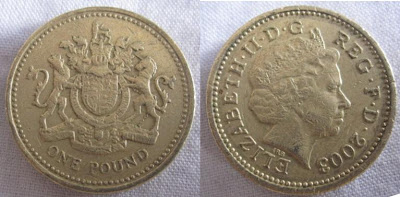England coat of arms
 The Royal Coat of Arms of the United Kingdom is the official coat of arms of the British monarch, currently Queen Elizabeth II.
The Royal Coat of Arms of the United Kingdom is the official coat of arms of the British monarch, currently Queen Elizabeth II.
The shield is quartered, depicting in the first and fourth quarters the three passant guardant lions of England; the rampant lion of Scotland in the second; and in the third, a harp for Northern Ireland.
The crest is a statant guardant lion wearing the imperial crown, himself on another representation of that crown.
The dexter supporter is a likewise crowned English lion; the sinister, a Scottish unicorn. According to legend a free unicorn was considered a very dangerous beast; therefore the heraldic unicorn is chained, as were both supporting unicorns in the Royal coat of arms of Scotland.
 The Royal Coat of Arms of the United Kingdom is the official coat of arms of the British monarch, currently Queen Elizabeth II.
The Royal Coat of Arms of the United Kingdom is the official coat of arms of the British monarch, currently Queen Elizabeth II.The shield is quartered, depicting in the first and fourth quarters the three passant guardant lions of England; the rampant lion of Scotland in the second; and in the third, a harp for Northern Ireland.
The crest is a statant guardant lion wearing the imperial crown, himself on another representation of that crown.
The dexter supporter is a likewise crowned English lion; the sinister, a Scottish unicorn. According to legend a free unicorn was considered a very dangerous beast; therefore the heraldic unicorn is chained, as were both supporting unicorns in the Royal coat of arms of Scotland.
The coat features both the motto of English monarchs, Dieu et mon droit (God and my right), and the motto of the Order of the Garter, Honi soit qui mal y pense (Shamed be he who thinks ill of it) on a representation of the Garter behind the shield.
1 pound, 1983
 Weight: 9.5gm
Weight: 9.5gm
Metal: Nickel-brass
22.5mm
Reverse: England coat of arms
Obverse: queen Elizabeth II
 Weight: 9.5gm
Weight: 9.5gmMetal: Nickel-brass
22.5mm
Reverse: England coat of arms
Obverse: queen Elizabeth II
1 pound, 1993

Edge lettering on pound coins

 The edge lettering on the pound coins reads: "decus et tutamen" meanning an ornament and a safeguard was originally there on some 17th century coins and was meant to be for the edge as a protection for the precious metal. This phrase originally appeared in a poem by Virgil describing a breast plate interwoven with gold which was awarded to Menestheus as a prize.
The edge lettering on the pound coins reads: "decus et tutamen" meanning an ornament and a safeguard was originally there on some 17th century coins and was meant to be for the edge as a protection for the precious metal. This phrase originally appeared in a poem by Virgil describing a breast plate interwoven with gold which was awarded to Menestheus as a prize.
1 pound, 2003


Polska Tututut
ReplyDelete